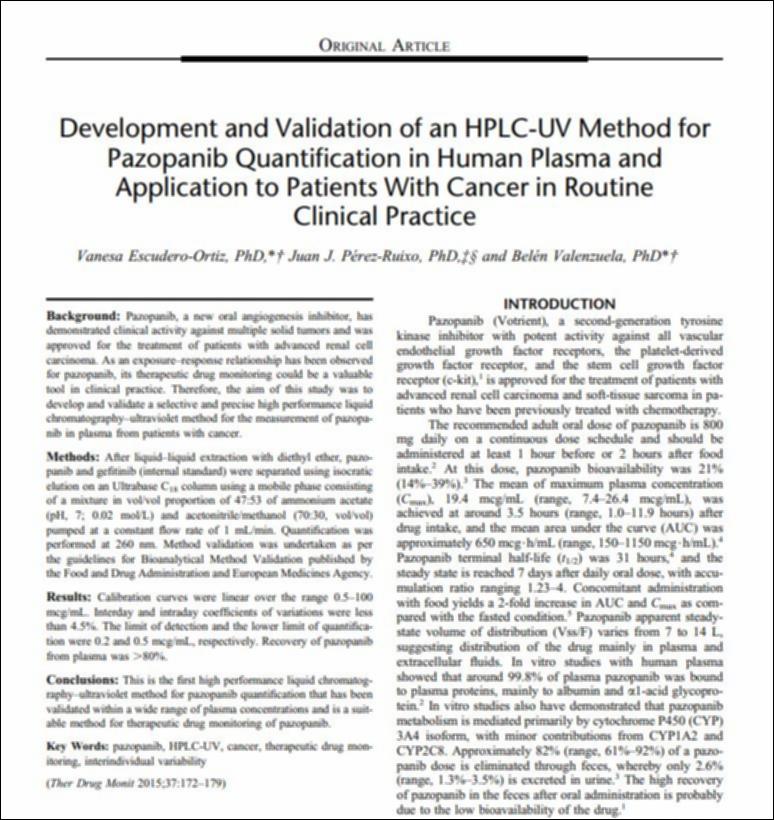Please use this identifier to cite or link to this item:
http://hdl.handle.net/10637/14897Development and validation of an HPLC-UV method for pazopanib quantification in human plasma and application to patients with cancer in routine clinical practice

See/Open:
Development_Escudero_TDM_2015.JPG
193,38 kB
JPEG
See/Open:
Development_Escudero_TDM_2015.pdf
Restricted Access
454,23 kB
Adobe PDF
Request a copy
| Title: | Development and validation of an HPLC-UV method for pazopanib quantification in human plasma and application to patients with cancer in routine clinical practice |
| Authors : | Escudero Ortiz, Vanesa Pérez Ruixo, Juan José Valenzuela, Belén |
| Keywords: | Cáncer; Cancer; Medicamento; Drugs; Tratamiento médico; Medical treatment |
| Publisher: | Wolters Kluwer |
| Citation: | Escudero-Ortiz, V., Pérez-Ruixo, J.J. & Valenzuela, B. (2015). Development and validation of an HPLC-UV method for pazopanib quantification in human plasma and application to patients with cancer in routine clinical practice. Therapeutic Drug Monitoring, vol. 37, i. 2 (apr.), pp. 172–179. DOI: https://doi.org/10.1097/FTD.0000000000000121 |
| Abstract: | Background: Pazopanib, a new oral angiogenesis inhibitor, has demonstrated clinical activity against multiple solid tumors and was approved for the treatment of patients with advanced renal cell carcinoma. As an exposure-response relationship has been observed for pazopanib, its therapeutic drug monitoring could be a valuable tool in clinical practice. Therefore, the aim of this study was to develop and validate a selective and precise high performance liquid chromatography-ultraviolet method for the measurement of pazopanib in plasma from patients with cancer. Methods: After liquid-liquid extraction with diethyl ether, pazopanib and gefitinib (internal standard) were separated using isocratic elution on an Ultrabase C18 column using a mobile phase consisting of a mixture in vol/vol proportion of 47:53 of ammonium acetate (pH, 7; 0.02 mol/L) and acetonitrile/methanol (70:30, vol/vol) pumped at a constant flow rate of 1 mL/min. Quantification was performed at 260 nm. Method validation was undertaken as per the guidelines for Bioanalytical Method Validation published by the Food and Drug Administration and European Medicines Agency. Results: Calibration curves were linear over the range 0.5-100 mcg/mL. Interday and intraday coefficients of variations were less than 4.5%. The limit of detection and the lower limit of quantification were 0.2 and 0.5 mcg/mL, respectively. Recovery of pazopanib from plasma was >80%. Conclusions: This is the first high performance liquid chromatography-ultraviolet method for pazopanib quantification that has been validated within a wide range of plasma concentrations and is a suitable method for therapeutic drug monitoring of pazopanib. |
| Description: | Este recurso no está disponible en acceso abierto por política de la editorial. |
| URI: | http://hdl.handle.net/10637/14897 |
| Rights : | http://creativecommons.org/licenses/by-nc-nd/4.0/deed.es |
| ISSN: | 0163-4356 1536-3694 (Electrónico) |
| Issue Date: | Apr-2015 |
| Center : | Universidad Cardenal Herrera-CEU |
| Appears in Collections: | Dpto. Ciencias Biomédicas |
Items in DSpace are protected by copyright, with all rights reserved, unless otherwise indicated.

